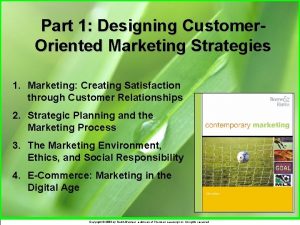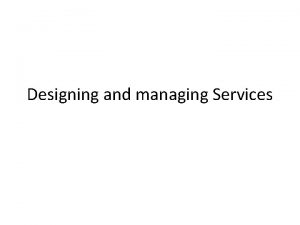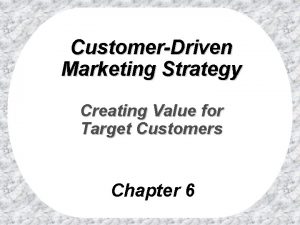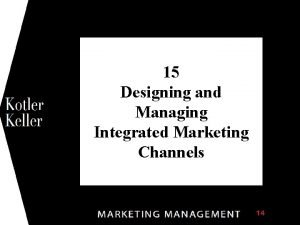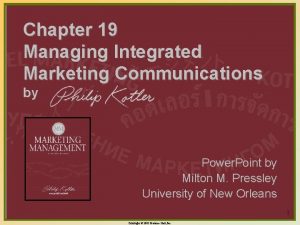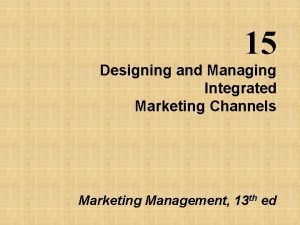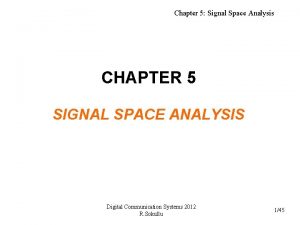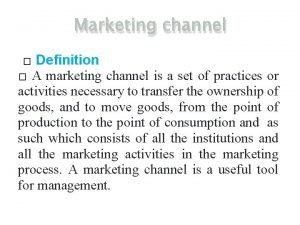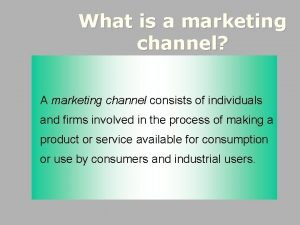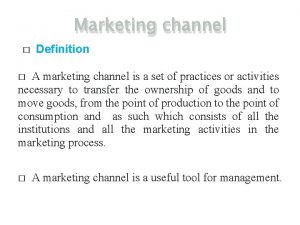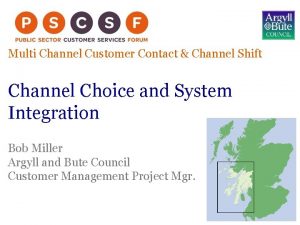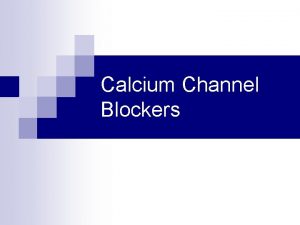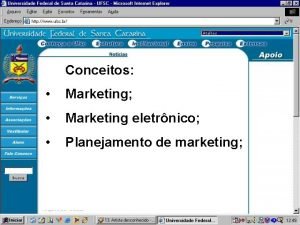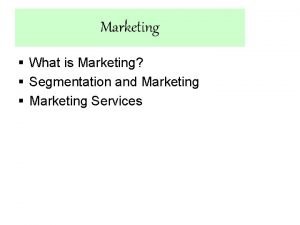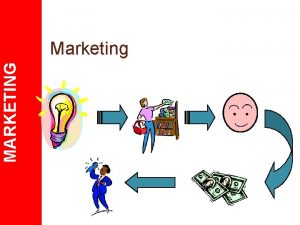6 Designing the Marketing Channel What is Channel






























- Slides: 30

6 Designing the Marketing Channel

What is Channel Design There are variations in usage of the term ‘design’ of marketing channel: • a noun to describe channel structure • The formation of a new channel from scratch • Modifications to existing channels • ‘Selection’

What is Channel Design • It refers to those decisions involving the development of new marketing channels where none had existed before, or to modification of existing channels.

Channel Design Key distinguished points associated with channel design: • It is presented as a decision faced by the marketer (same as other marketing mix). • It is used in the broader sense to include either setting up channels from the scratch or modifying existing channels (reengineering). • The management has taken a proactive role in the development of the channel. • The term ‘selection’ refers to only 1 phase of channel design (selection of the actual channel members). • It is a strategic tool for gaining a differential advantage.

Who Engages in Channel Design Producers/ Manufacturers Wholesalers Retailers Market

A Paradigm of the Channel Design Decision The channel design decision can be broken down into 7 phases or steps: 1. Recognizing the need for a channel design decision 2. Setting and coordinating distribution objectives 3. Specifying the distribution tasks 4. Developing possible alternative channel structures

A Paradigm of the Channel Design Decision The channel design decision can be broken down into 7 phases or steps: 5. Evaluating the variables affecting channel structures 6. Choosing the best channel structure 7. Selecting the channel members (see ch. 7)

Phase 1: Recognizing the Need for a Channel Design Decision Many situations can indicate the need for a channel design decision. Among them are the following: 1. Developing a new product/product line 2. Aiming an existing product at a new target market (i. e. additional channel from b 2 b to b 2 c) 3. Making a major change in some other component of the marketing mix (i. e. new pricing policy emphasizing lower prices) 4. Establishing a new firm 5. Adapting to changing intermediary policies (i. e. if intermediaries begin to emphasize their own private brands, adding new distributors for the manufacturer may be needed. )

Phase 1: Recognizing the Need for a Channel Design Decision Many situations can indicate the need for a channel design decision. Among them are the following: 6. Dealing with changes in availability of particular kinds of intermediaries (i. e. reducing number of prestigious department stores in the U. S. affected French manufacturers of luxury goods) 7. Opening up new geographic marketing areas (territories) 8. Facing the occurrence of major environmental changes 9. Meeting the challenge of conflict or other behavioral problems (i. e. A loss of power by a manufacturer to his/her distributors or communication difficulties) 10. Reviewing and evaluating undertaking by a firm may point to the need for changes in existing channels/ need for new channels

Phase 2: Setting and Coordinating Distributing Objectives In order to set distribution objectives that are well coordinated with other marketing and firm objectives and strategies, the channel manager needs to perform 3 tasks: 1. Become familiar with the objectives and strategies in the other marketing mix areas 2. Set distribution objectives and state them explicitly 3. Check to see if the distribution objectives set are congruent with marketing and other general objectives and strategies of the firm

Phase 2: Setting and Coordinating Distributing Objectives 1. Becoming familiar with the objectives and strategies in the other marketing mix areas Short shelf life Strategic emphasis on the “Freshness” Uses almost 13, 000 drivers/salespeople to deliver products directly to grocery stores Longer shelf life

Phase 2: Setting and Coordinating Distributing Objectives 2. Set distribution objectives and state them explicitly Example: IBM originally was to “have retailers displaying PCs within driving distance of anyone in the U. S. who wanted to buy one”. Later, when IBM decided to use mail order channels, its distributor objective was broadened to “make its PCs directly available wherever its customers are”

Phase 2: Setting and Coordinating Distributing Objectives 3. Check to see if the distribution objectives set are congruent with marketing and other general objectives and strategies of the firm Firm’s overall objectives and strategies *Interrelationships and Hierarchy of Objectives and Policies in the Firm General marketing objectives and strategies Product objectives and strategies Pricing objectives and strategies Promotion objectives and strategies Distribution objectives and strategies

Phase 3: Specifying the Distribution Tasks (Functions) • The kinds of tasks required to meet specific distribution objectives must be precisely stated and situationally dependent on the firm. Example: A manufacturer of high-quality tennis racquets aimed at serious amateur tennis players would need to specify distribution tasks as the following:

Phase 3: Specifying the Distribution Tasks (Functions) Example: 1. Gather info. on target market shopping patterns 2. Promote product availability in the target market 3. Maintain inventory storage to assure timely availability 4. Compile info. about product features 5. Provide for hands-on tryout of product 6. Sell against competitive products

Phase 3: Specifying the Distribution Tasks (Functions) Example: 7. Process and fill specific customer orders 8. Transport the product 9. Arrange for credit provisions 10. Provide product warranty service 11. Provide repair and restringing service 12. Establish product return procedure

Phase 4: Developing Possible Alternative Channel Structures 1. Number of levels in the channel 2. Intensity at the various levels Allocation Alternatives 3. Types of intermediaries at each level

Phase 4: Developing Possible Alternative Channel Structures Number of Levels • Range from two to five or more • Number of alternatives is limited to two or three choices • Limitations result from the following factors: – Particular industry practices – Nature & size of the market – Availability of intermediaries

Phase 4: Developing Possible Alternative Channel Structures Intensity at the Various Levels • Relationship between the intensity of distribution dimension & number of retail intermediaries used in a given market area Intensity Dimension Intensive Selective Exclusive Numbers of Intermediaries (retail level) Many Few One

Phase 4: Developing Possible Alternative Channel Structures Types of Intermediaries • Numerous types • Manager’s emphasis on types of distribution tasks performed by these intermediaries • Should not overlook new emerged intermediary types: – Electronic online auction firms (e. Bay) – Industrial products sold in B 2 B markets (Chemdex, Converge. com)

Phase 5: Evaluating the Variables Affecting Channel Structure Categories of Variables 1. 2. 3. 4. 5. 6. Market Variables Product Variables Company Variables Intermediary Variables Environmental Variables Behavioral Variables

Phase 5: Evaluating the Variables Affecting Channel Structure 1. Market Variables Market Geography Location, geographical size, & distance from producer Market Size Number of customers in a market Market Density Number of buying units (consumers or industrial firms) per unit of land area Market Behavior Who buys, & how, when, and where customers buy

Phase 5: Evaluating the Variables Affecting Channel Structure 2. Product Variables Bulk & Weight -> heavy & bulky product -> high handling & shipping costs -> minimize costs by shipping in large lots to fewest possible points Perishability (fresh products) -> channel structure should be designed to provide for rapid delivery from producers to consumers Unit Value -> lower unit value product (convenience goods) -> create small margin for distribution costs -> should use the longer channel Degree of Standardization -> can lengthen the channel by increase intermediaries unlike the custom-made products (i. e. industrial machinery) often sold directly from manufacturer to the user Technical versus Nontechnical –> highly technical product -> needed the technical advice, after sales service from the expert -> generally be distributed through a direct channel Newness -> new product -> require extensive & aggressive promotion in the introduction stage -> a shorter channel will enable such promotional effort

Phase 5: Evaluating the Variables Affecting Channel Structure 3. Company Variables Size The range of options is relative to a firm’s size Financial Capacity The greater the capital, the lower the dependence on intermediaries Managerial Expertise Intermediaries are necessary when managerial experience is lacking Objectives & Strategies Marketing & objectives may limit use of intermediaries

Phase 5: Evaluating the Variables Affecting Channel Structure 4. Intermediary Variables Availability Cost Services Availability of intermediaries influences channel structure. Cost is always a consideration in channel structure. Services that intermediaries offer are closely related to the selection of channel members.

Phase 5: Evaluating the Variables Affecting Channel Structure 5. Environmental Variables Economic Competitive Sociocultural The impact of environmental forces is a common reason for making channel design decisions. Technological Legal

Phase 5: Evaluating the Variables Affecting Channel Structure 6. Behavioral Variables Develop congruent roles for channel members. Be aware of available power bases. Attend to the influence of behavioral problems that can distort communications.

Phase 6: Choosing the “Best” Channel Structure Heuristics in Channel Design Benefit Fairly simple prescriptions for channel structure Limitation Mostly useful as rough guide to decision making

Phase 6: Choosing the “Best” Channel Structure Approaches for Choosing Channel Structure • “Characteristics of Goods & Parallel Systems” Approach • Financial Approach • Transaction Cost Analysis Approach • Management Science Approaches • Judgmental-Heuristic Approach

Phase 6: Choosing the “Best” Channel Structure Judgmental-Heuristic Approach IF Management’s ability to make sharp judgments is high + Good empirical data on costs and revenues is available It’s possible to make highly satisfactory channel-choice decisions using judgmental-heuristic approaches
 Channel design decision
Channel design decision Designing customer oriented marketing channels
Designing customer oriented marketing channels Designing brand marketing programs
Designing brand marketing programs Nature and characteristics of service marketing
Nature and characteristics of service marketing Designing a customer driven marketing strategy
Designing a customer driven marketing strategy Designing and managing integrated marketing communications
Designing and managing integrated marketing communications Designing and implementing brand strategies
Designing and implementing brand strategies Designing and managing integrated marketing communications
Designing and managing integrated marketing communications Designing and implementing branding strategies
Designing and implementing branding strategies Channel
Channel Designing and managing integrated marketing channels
Designing and managing integrated marketing channels Designing and managing integrated marketing channels
Designing and managing integrated marketing channels Managing integrated marketing communications
Managing integrated marketing communications Four market targeting strategies
Four market targeting strategies Managing integrated marketing communication process
Managing integrated marketing communication process Designing and managing integrated marketing channels
Designing and managing integrated marketing channels Single channel multichannel omnichannel
Single channel multichannel omnichannel Conversion of continuous awgn channel to vector channel
Conversion of continuous awgn channel to vector channel Jfet self bias configuration
Jfet self bias configuration Hát kết hợp bộ gõ cơ thể
Hát kết hợp bộ gõ cơ thể Frameset trong html5
Frameset trong html5 Bổ thể
Bổ thể Tỉ lệ cơ thể trẻ em
Tỉ lệ cơ thể trẻ em Voi kéo gỗ như thế nào
Voi kéo gỗ như thế nào Glasgow thang điểm
Glasgow thang điểm Chúa yêu trần thế alleluia
Chúa yêu trần thế alleluia Các môn thể thao bắt đầu bằng tiếng bóng
Các môn thể thao bắt đầu bằng tiếng bóng Thế nào là hệ số cao nhất
Thế nào là hệ số cao nhất Các châu lục và đại dương trên thế giới
Các châu lục và đại dương trên thế giới Công của trọng lực
Công của trọng lực Trời xanh đây là của chúng ta thể thơ
Trời xanh đây là của chúng ta thể thơ

